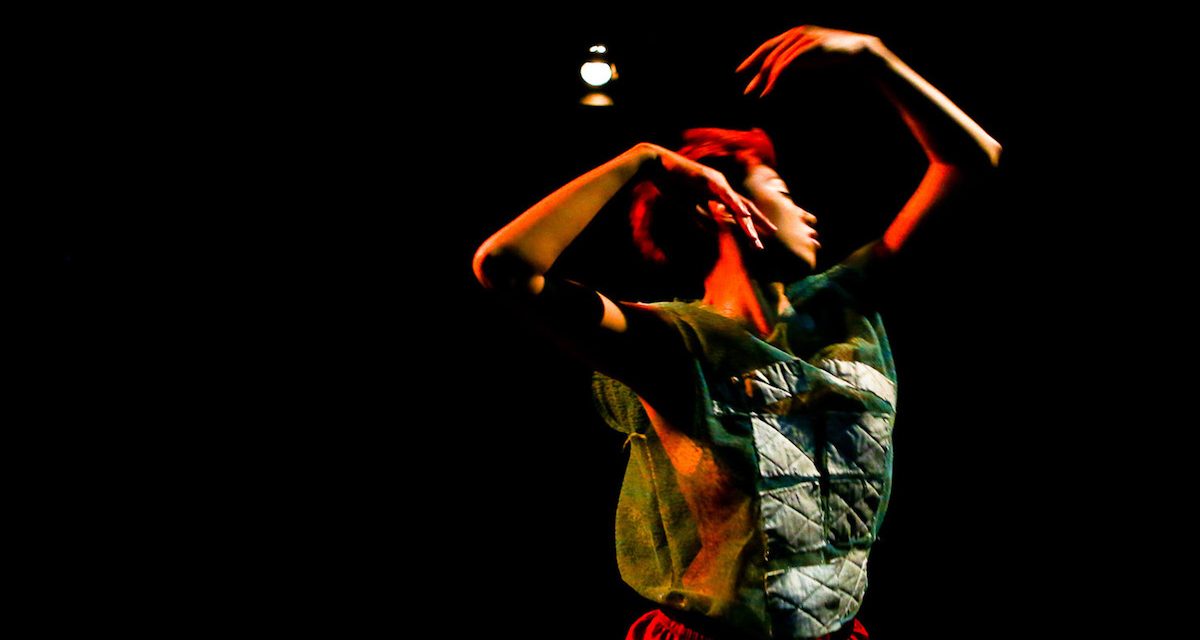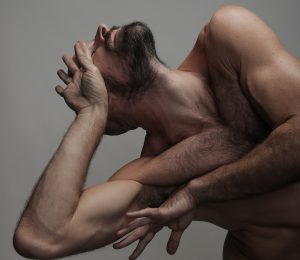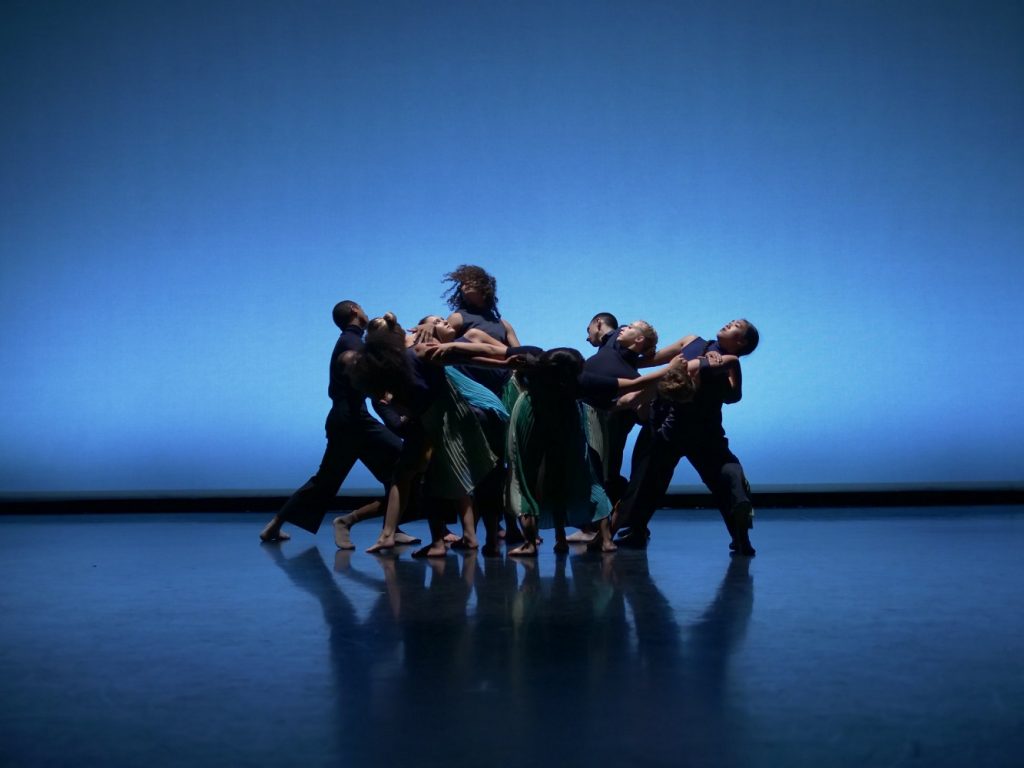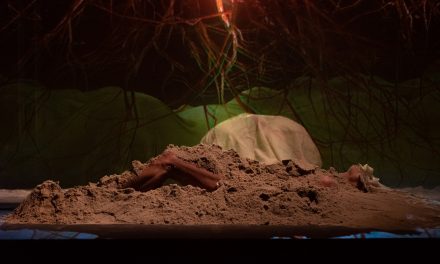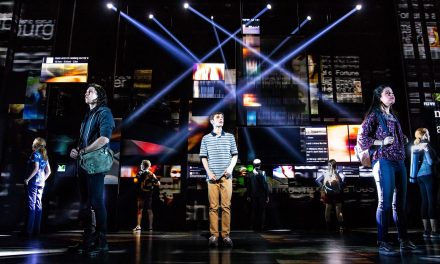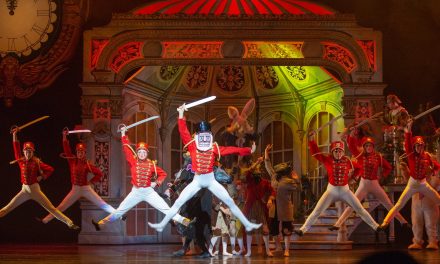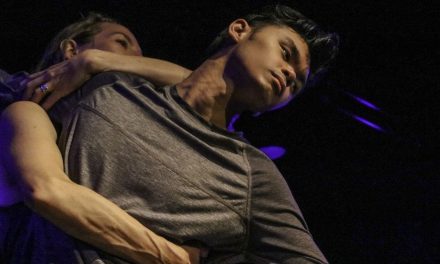Twisted, disjointed and bent, Kevin Williamson brought every available synonym of Gnarled to mind with the premiere of his three-part show rounding off Dance at the Odyssey’s fourth annual festival the weekend of February 8 through 10. The work was innovative, evocative and stunning in some moments, and fell into generic potholes at others. Williamson’s strength as a choreographer is unquestionable, but some of the pieces may have benefited from having been a bit more polished.
“return” initiated the show with an ensemble of eleven dancers who took the stage before the lights had dimmed, forming couples that immediately began facing and touching one another on the shoulder while remaining stony-faced, as though going through the motions without feeling the gestures. Nao Aizawa, emerged between the pairs alone. The surrounding group broke apart to stand against a wall and stare at Aizawa covering her face and whipping her hair back and forth in anguish. The solo triggered each performer to split away from their partner and spread around the space, exploring their own movement within it.
Their postures grew more open and their limbs longer as they flowed into new routines, which were punctuated by many of the performers pausing one at a time, parting from the crowd with vacant expressions. These small breaks seemed unnoticed by the rest, but anyone bold enough to dance on their own was subject to more staring. The pairs inevitably reconvened as each dancer searched through the group for their next partner, begging for warmth in empty hugs.
An endless cycle of groupthink and stunted individualization resulted in a lack of variety in the choreography. The message was stronger than the dancing.
However, in one brilliant segment, one of each pair of performers stood center stage while their other half ran circles around them. The eleventh member ran around the entire group. As the runners’ paces quickened the stationary dancers whipped their heads around faster and faster to follow their partners’ movements, and the rotations and revolutions began to resemble a galactic solar system. The group eventually folded into a massive huddle that exploded into a pulsing and vibrating Big Bang as each person hopped backward away from the explosion, their short beats emphasized by bleeping points of sound in Nico Muhly’s “Drones in Large Cycles”. This became the crux of the dance—a scene Williamson could have explored further.
“New Friday Night” was the most impactful of the three pieces and easily the star of Williamson’s show. A duet between him and Jasmine Jawato, the work began with soundbites about the June 2016 Orlando nightclub shooting. A yellowed spotlight outlined both dancers who were clad in billowy black sequined pants (designed by Kelsie Vidie) and nothing else as they began dancing with their backs to the audience. The two performed small, repetitive beats to Wajeed’s “Frances”, a futuristic and other-worldly electronic rhythm with a distinct disco vibe.
Williamson’s choreography was based in pure physicality—most of the movements were simple swan dives against the floor, butterfly arms and back rolls in sitting or squatted positions. Their flexing muscles established a mesmerizing ebb and flow, especially due to the sharp physical contrast between the duo, who never interacted with one another, but always followed the same pattern. The dancing, like the music, built up slowly, but never fully revealed the twosome’s faces, keeping viewers on edge until the very end. The closest they came to turning around was with a quick, backward stretch on the ground. Their arms kept pumping into the air to distract from their hardly visible faces. Regardless, their exposure transitioned them from absolute resilience to subtle vulnerability, just as the Orlando shootings strengthened the LGBTQ community’s resolve, while leaving many members feeling nude and unsafe.
Final piece “Gnarled” was a multi-sectioned work that began with a jolt but deflated into an ordinary number that had trouble following its ardent beginning and felt unfinished overall.
The introduction picked up on “New Friday Night”’s final notes of discomfort and took the emotion one step forward into fear. Four dancers—Barry Brannum, Mallory Fabian, Sebastian Hernandez and Carol McDowell—twisted and shoved their bodies against each other under a dim light. As Gesaffelstein’s “Ultra Violence”, a perfect horror movie score, rang out overhead, the writhing figure transformed into a creature with two heads, then five, growing arms until it shape-shifted into a towering centipede before slithering onto the floor, its indistinct contours concealing the true number of people creating the creature. Its shadow inched closer to the audience, until the being broke apart, revealing the quartet under a brighter light.
The dancing became less impressive from there. Next was a rendition of the Human Knot Game, performed to Gesaffelstein’s “Hate or Glory”—what started out as a clever device, ended up lasting a few rounds too many. Its abrupt end led to the ensemble sitting on the floor with virtually no transition, taking turns reading spoken word poetry about consent, permission, and owning one’s body. This moment, too, dragged on, and felt more like an interruption to what could have been more dynamic dancing, especially since the ballads’ point had already been illustrated so beautifully in the first scene. Luc Ferrari’s “Programme Commun” then engulfed the silence and the dancers free-styled their own, non-interactive contemporary movement phrases.
The choreography was forgettable up until Sarah Vaughan’s “Tenderly” took over the soundtrack and the foursome began slowing down before splitting into two pairs. Each praised unity with sudden sensual attachment mostly expressed through touching heads and pressing torsos. Unlike “return”, the movements aimed for a more purposeful connection. However, Fabian and McDowell’s interactions still seemed forced. Among the two, Brannum and Hernandez were the most convincing—a tender moment saw Hernandez placing his cheek against Brannum’s thigh as Brannum pet his hair and reassured him with immovable eye contact.
“Gnarled” ended poignantly with the ensemble rolling into a tight, tangled ball of limbs, faces buried beneath bodies, all heaving until finally letting go and falling into a relaxed state of acceptance.
Perhaps the show would have been stronger opening with “New Friday Night”, Williamson’s most complete piece. This would have jumpstarted the viewer’s curiosity from the get-go before moving into “return”, then “Gnarled”. Though the dancing strayed into pitfalls of predictability, some of the images made lasting impressions, which marketed Williamson’s signature well—a style one could get lost in when fully developed.
For more information about Kevin Williamson + Company, click here.
For more information about The Odyssey Theater Ensemble, click here.
Featured image: Kevin Williamson + Company. Photo by Taso Papadakis.

